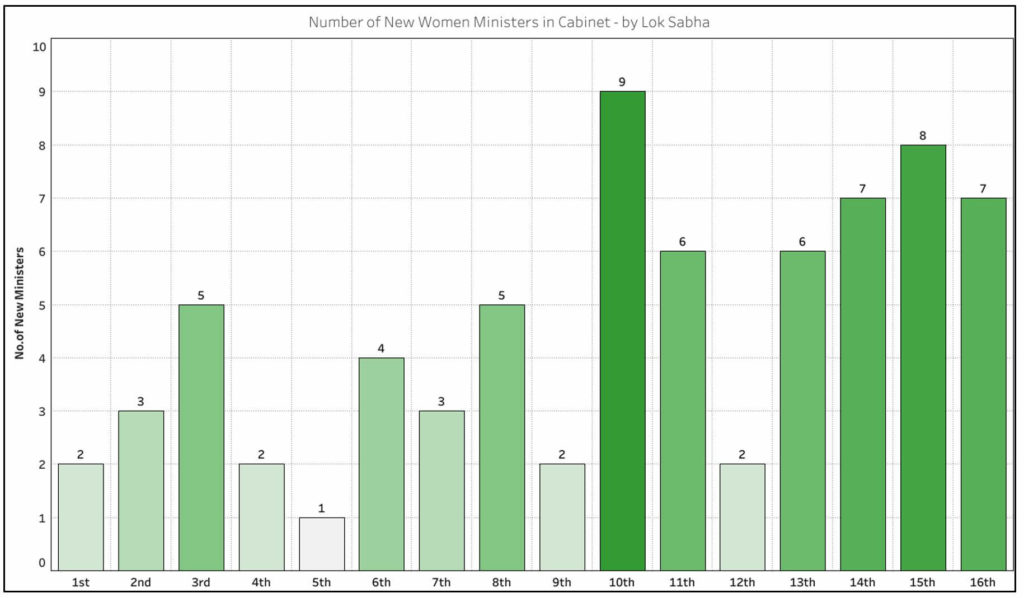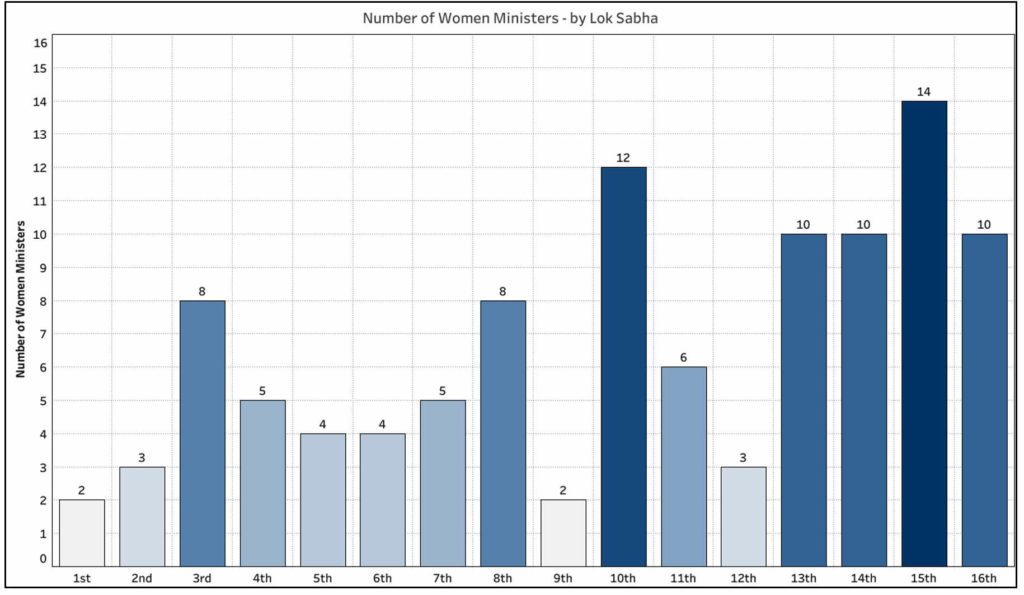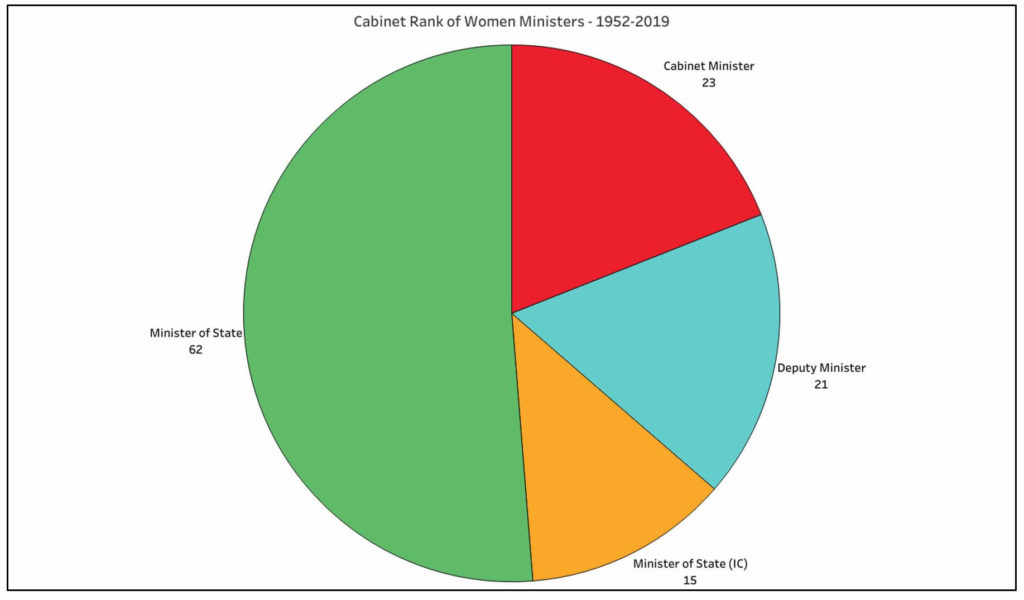Unlike in most other democracies, Women have been a part of the Union Council of Ministers in India from the first ever Lok Sabha in 1952. However, their representation & role has been limited. Here is a detailed data-based analysis of the women in the union council of ministers from 1952 to 2019.
The first woman to be a part of US cabinet was in the year 1933, more than 130 years after the formation of its first cabinet. The United Kingdom gave place to a woman in its cabinet in the year 1929, which was quite late in their democratic history. The same is the case with many other democracies in Europe, with women being inducted into the cabinets around the same period.
However, whether it could be the influence of times where in women being part of the cabinet has become an accepted idea or the idea of providing equal opportunity in lines with provision of ‘Universal Adult Franchise’ since the very first election, India had women representation in the union council of ministers from the very first government.
In this story we take a look at the representation of women in various union cabinets, the portfolios they held etc. The data is collated from various sources, which includes – archived compilation of council ministers since independence, the information in respect to the change in portfolios since 1952, the archival data of council of ministers since 1990s and the handbook on council of ministers 1947-2015.
Factly has earlier published a story, which enlists all the women in the union council of ministers from the time of the first government. For this analysis, we are excluding the current i.e. 17th Lok Sabha since it is ongoing and there is scope for changes in the future.
Until 2019, 72 women have been part of Union Council of Ministers
From the time of the first Lok Sabha (1952-57) to the 16th Lok Sabha (2014-19), 72 different women have taken up various positions & portfolios in the union council of ministers. These include the positions of Cabinet Minister, Deputy Minister & Minister of State (MoS).
The first woman cabinet minister was Rajkumari Amrit Kaur of Indian National Congress. She became the Cabinet Minister for Health during the first Lok Sabha (1952-57). The first Lok Sabha also included another woman in the position of Deputy minister, Maragatham Chandra Shekhar. She was the deputy minister for Health.
The first non-congress women in Union Council of Ministers were Sathiavani Muthu and Abha Maiti of ADMK & Janata party respectively. Both of them were part of Charan Singh’s Cabinet between 1979-80. Muthu was the Cabinet Minister of Rural Development while Abha Maiti was MoS in Ministry of Industry.
Of the 72 women who were part of the union council, 10 were given the rank of Cabinet minister in their first stint. Most of the women ministers were given the rank of MoS.

The highest number of new women inductees was during 10th Lok Sabha
P.V.Narasimha Rao’s council of ministers of the 10th Lok Sabha i.e. between 1991-96 included 12 women ministers. Out of these, 9 were given the opportunity for the first time. They were inducted into the union council at different periods and none of them served a full term. Furthermore, none of these 9 new ministers were given the rank of Cabinet ministers.
The 15th Lok Sabha i.e. 2009-14, had the second-highest number of new women ministers in the council of ministers with 8. In terms of providing rank of Cabinet Minister for first time ministers, the 16th Lok Sabha i.e. 2014-19 ranks top, when 3 new women ministers were given the cabinet rank.

Council of Ministers during 15th Lok Sabha had the highest number of Women Ministers
As highlighted earlier, the first Lok Sabha during 1952-57 had only two women ministers. The women representation in the subsequent Lok Sabha tenures have been higher with the exception of the 9th Lok Sabha (1989-91), where only 2 women have served as ministers. However, they served in two different governments as Maneka Gandhi was part of VP Singh’s government, whereas Usha Sinha was part of Chandra Sekhar’s government.
While the first non-congress government formed at the Centre under Morarji Desai in 1977 did not have any women in the council of ministers, the new short-lived government under Charan Singh during the same Lok Sabha had 4 women ministers, including the first two non-congress ministers as highlighted earlier.
The 11th Lok Sabha tenure (1996-98) had three different Prime Ministers and the respective council of ministers led by A.B.Vajpayee, H.D.Deve Gowda and I.K.Gujral.
The highest number of women in the union council of ministers during a Lok Sabha tenure was in the 15th Lok Sabha i.e. 2009-14, wherein 14 different women have been made ministers. Of these, 4 women held the rank of Cabinet Minister, while 2 were MoS with independent charge and the rest of 8 women were MoS in different ministries.

Around half of the Women Ministers had the rank of Minister of State
All through the 16 Lok Sabha tenures and the respective council of ministers formed during this period, the Minister of State (MoS) is the most common rank given to women ministers. They have been given this rank on 62 separate occasions. It has to be noted that this is by the rank in the union council of ministers and not based on the portfolio i.e. a minister holding multiple portfolios during a government’s tenure of the same rank is treated as one.
Meanwhile, any change in the rank is considered i.e. if an MoS is elevated to Cabinet minister, these are considered as individual instances. For instance, Nirmala Sitharaman during the 16th Lok Sabha tenure was MoS for Finance as well MoS for Corporate affairs, MoS (IC) for Commerce & Industry and Cabinet Minister for Defence. Hence, she is categorized under three categories.
Indira Gandhi was the Prime Minister during the 3rd, 4th, 5th and 7th Lok Sabha. In the respective council of ministers, she held multiple portfolios and also included several women ministers. However, none of these women ministers were provided the Cabinet rank.

Information & Broadcasting followed by Culture are the most common Portfolios held by Women
Indira Gandhi served as the Prime Minister of India during 3rd,4th, 5th & 7th Lok Sabha, during which time she held many portfolios in addition to her position as the Prime Minister. This includes a few key portfolios like Home Ministry, Defence, Finance & External Affairs. For the purpose of this analysis, we have excluded Indira Gandhi since hers is a special case and have focused on those women who have been part of the council of ministers as only ministers.
Among the portfolios handled by women with Cabinet Rank, Information & Broadcasting (I & B) Ministry is the most common with women holding this on 4 instances. The next common portfolio is Culture.
Among the key portfolios, Mamatha Banerjee was Minister for Railways during the 13th Lok Sabha. Sushma Swaraj and Nirmala Seetharaman were the Cabinet Ministers for External Affairs and Defence during the 16th Lok Sabha.
Nirmala Seetharaman also became the Union Minister for Finance in the 17th Lok Sabha (analysis not part of the story). Smriti Irani held the key portfolio of Human Resource Development for a short period during 16th Lok Sabha.
I&B also happens to be the common portfolio for the rank of Deputy Minister. Among the portfolios where women were MoS, Human Resource Development is the most common followed by Health & Family Welfare.
External Affairs is also very common (4 occasions) among the portfolios held by women as MoS.
Except for Maneka Gandhi (Cabinet Minister – 16th Lok Sabha) & Renuka Choudhary (MoS-IC – 14th Lok Sabha), women did not hold the cabinet rank or MoS (Independent Charge) in the Ministry of Women welfare or empowerment. Sushma Swaraj was the Cabinet Minister for Health & Family welfare – a related portfolio, during 13th Lok Sabha.

Need for greater representation of Women in key portfolios
Although India had women representation in the Union Council of Ministers from the time of the first Lok Sabha, their role was a nominal one in most of the governments that followed. With the exception of Indira Gandhi who held important portfolios on account of being the PM, none of the women ministers held key portfolios during most governments. Furthermore, as highlighted in the story, most women were given the rank of MoS and very few were given independent charge of a ministry.
There is some change over the past few Lok Sabhas where an increased number of women are given the Cabinet rank. However, making them in charge of key portfolios is still limited to stand-alone cases. Providing greater opportunities, including more women and making them in charge of key ministries is the only way forward in ensuring equitable distribution of power.


